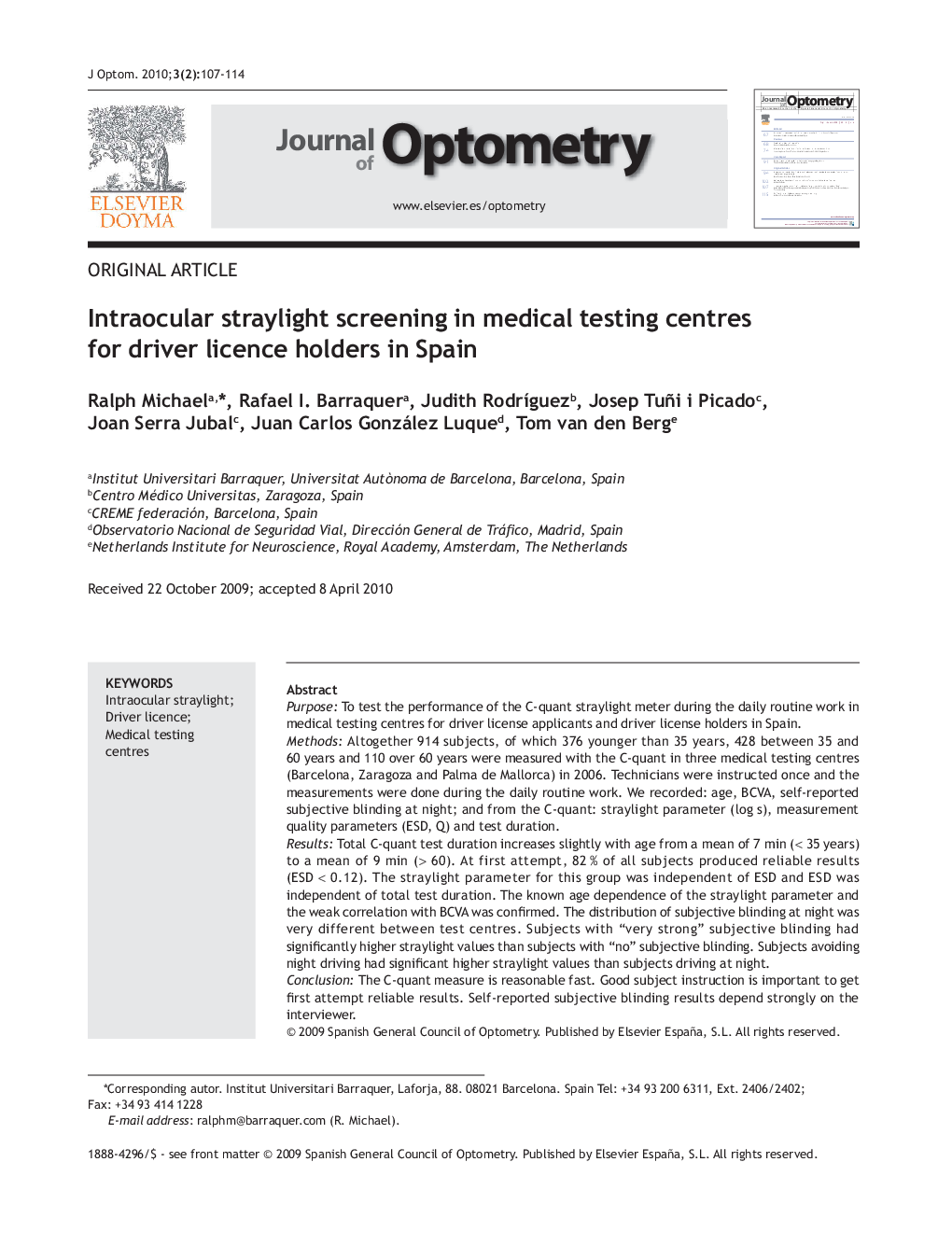| Article ID | Journal | Published Year | Pages | File Type |
|---|---|---|---|---|
| 2701019 | Journal of Optometry | 2010 | 8 Pages |
PurposeTo test the performance of the C-quant straylight meter during the daily routine work in medical testing centres for driver license applicants and driver license holders in Spain.MethodsAltogether 914 subjects, of which 376 younger than 35 years, 428 between 35 and 60 years and 110 over 60 years were measured with the C-quant in three medical testing centres (Barcelona, Zaragoza and Palma de Mallorca) in 2006. Technicians were instructed once and the measurements were done during the daily routine work. We recorded: age, BCVA, self-reported subjective blinding at night; and from the C-quant: straylight parameter (log s), measurement quality parameters (ESD, Q) and test duration.ResultsTotal C-quant test duration increases slightly with age from a mean of 7 min (< 35 years) to a mean of 9 min (> 60). At first attempt, 82 % of all subjects produced reliable results (ESD < 0.12). The straylight parameter for this group was independent of ESD and ESD was independent of total test duration. The known age dependence of the straylight parameter and the weak correlation with BCVA was confirmed. The distribution of subjective blinding at night was very different between test centres. Subjects with “very strong” subjective blinding had significantly higher straylight values than subjects with “no” subjective blinding. Subjects avoiding night driving had significant higher straylight values than subjects driving at night.ConclusionThe C-quant measure is reasonable fast. Good subject instruction is important to get first attempt reliable results. Self-reported subjective blinding results depend strongly on the interviewer.
ResumenObjetivoExaminar el rendimiento del sistema C-QuantTM de Oculus, un dispositivo que mide y cuantifica la cantidad de luz dispersa durante la actividad rutinaria diaria en los centros de revisiones médicas para solicitar o renovar el permiso de conducir en España.MétodosEn conjunto, 914 individuos, de los que 376 eran menores de 35 años de edad, 428 tenían 35-60 años y 110 eran mayores de 60 años, se sometieron al dispositivo C-Quant en tres centros de revisiones médicas (Barcelona, Zaragoza y Palma de Mallorca) en 2006. Se proporcionaron instrucciones a los técnicos y las determinaciones se efectuaron durante el trabajo rutinario diario. Registramos la edad, la mejor agudeza visual corregida (best corrected visual acuily [BCVA]), el deslumbramiento subjetivo nocturno autorreferido; y, a partir del dispositivo C-Quant, el parámetro de luz dispersa (log s), determinación de los parámetros de calidad (ESD,Q) y duración del examen.ResultadosLa duración total del examen C-Quant aumenta ligeramente con la edad desde una media de 7 min (< 35 años) hasta una media de 9 min (> 60 años). En el primer intento, el 82 % de todos los individuos produjeron resultados fiables (ESD < 0,12). Para este grupo, el parámetro de luz dispersa fue independiente de ESD y ESD fue independiente de la duración total del examen. Se confirmaron la conocida dependencia de la edad del parámetro de luz dispersa y la débil correlación con BCVA. La distribución del deslumbramiento subjetivo por la noche fue muy diferente entre centros que efectuaron el examen. En individuos con un deslumbramiento subjetivo “muy intenso” se obtuvieron valores de luz dispersa significativamente más altos que en aquéllos sin deslumbramiento subjetivo. Los individuos que evitaban conducir de noche obtuvieron valores de luz dispersa significativamente más altos que los que conducían de noche.ConclusiónEl parámetro C-Quant es razonablemente rápido. Es importante proporcionar instrucciones apropiadas a los individuos para obtener resultados fiables en el primer intento. Los resultados de deslumbramiento subjetivo autorreferido dependen potentemente del entrevistador.
